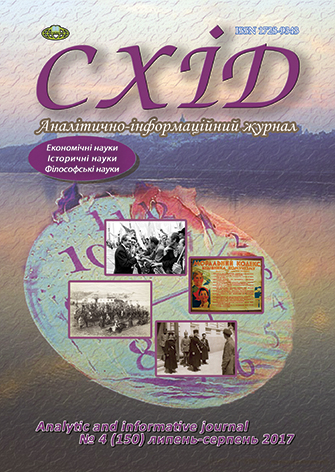The Richard Hayesh's hermeneutics: from the narrative substructure of the holy letter to Christian ethics
DOI:
https://doi.org/10.21847/1728-9343.2017.4(150).111559Keywords:
echoes of Scripture, narrative substructure, intertextual approach, theological imaginationAbstract
The purpose of this article is an attempt to consider the theoretical contribution of Richard Hays in the development of theological hermeneutics. Richard Hayes uses Scripture as the basis for ethical discourse and transformation of the community of the people of God these days. He proposes to conduct creative analogies between the stories of the texts and the story that the church lives in completely different historical circumstances. The innovative view of Richard Hays in hermeneutics is revealed in the reconciliation of the narratives of Scripture and the description of New Testament ethics against the background of changes in the understanding of New Testament letters that include the transition from exegetical attempts to extract "truth" claims based on Paul's letters to the study of Paul's theology as a dialogical intersection with certain historical circumstances. Instead of statements, Hayes offers stories. Instead of dogma, Hayes offers drama. Hayes sees the apostle Paul as a creative thinker with a rich imagination that has become part of the history of God's redemption of humanity, and encourages his readers to see themselves as part of this same history of redemption, which continues today. Analyzing the contribution of Richard Hays in the understanding of hermeneutics of Paul, several directions are revealed in his research: the narrative substructure in Scripture, the intertextual approach to understanding the use of the Old Testament on the pages of the New, the influence of hermeneutic approaches in understanding of ethical issues.
Downloads
References
Hays, Richard B. (2011), Echoes of Scripture in the Letters of Paul [translat.], Kollokvium, Cherkassy(rus).
Hays, Richard B. (2005), The Moral Vision of the New Testament [translat.], BBI, Moscow, 712 p. (rus).
Ellis, E.E. (2003), Paul’s Use of the Old Testament, Wipf and Stock Publishers, Oregon, 115-116 p. (eng)
Hays, Richard B. (1989), Echoes of Scripture in the Letters of Paul, Yale University Press, New Haven.
Rosner, B.S. (1999), Paul, Scripture, and Ethics: A Study of 1 Corinthians 5-7, Grand Rapids, Baker (eng)
Ciampa, R. (2012), Approaching Paul’s Use of Scripture in Light of Translation Studies. In Stanley C. (Ed.), Paul and Scripture: Extending the Conversation (pp. 293-318). Atlanta: Society of Biblical Literature. DOI:10.2307/j.ctt32bzfp.16
Beale, G. K. (1998), John’s Use of the Old Testament in Revelation, Sheffield Academic Press, Sheffield (eng).
Keesmaat, Sylvia C. (1999), Paul and His Story: (Re)Interpreting the Exodus Tradition, Sheffield Academic, Sheffield (eng).
Longenecker, B.W. (2002), Narrative Dynamics in Paul: A Critical Assessment, Westminster John Knox, Louisville (eng).
Longernecker, Richard (1999), Biblical Exegesis in the Apostolic Period, Grand Rapids, Eerdmans, Michigan, 104-5 p., 205-9 p. (eng).
Sanders, James A. (1987), From Sacred Story to Sacred Text, Wipf and Stock Publishers, Eugine, 41-60 p. (eng).
Hays, Richard B. (2002), The Faith of Jesus Christ: The Narrative Substructure of Galatians 3:1-4:11, Grand Rapids, Eerdmans (eng).
Greimas, A. Zh. (2004), Structural semantics, Academic Project, Moscow, 178-257 p. (rus).
Kristeva, Yu. (2004), Selected Works: The Destruction of Poetics [Translat.], «The Russian Political Encyclopedia» (ROSSPEN), Moscow, 454 p. (rus).
Hollander, John (1981), Figure of Echo: A Mode of Allusion in Miltonand After, University of California Press, Berkeley, 65 p. (eng).
Greene, Thomas M. (1982), The Light in Troy: Imitation and Discovery in Renaissance Poetry, Yale University Press, New Haven (eng).
Graham, Allen (2000), Intertextuality. The New Critical Idiom, Routledge, London, 9-60 p. (eng).
Wagner, J. Ross (2002), Heralds of the Good News: Isaiah and Paul “in Concert” in the Letter to the Romans, Brill, Leiden (eng)
Downloads
Published
How to Cite
Issue
Section
License
Copyright (c) 2017 Volodymyr Gorbenko

This work is licensed under a Creative Commons Attribution-NonCommercial-NoDerivatives 4.0 International License.
1. Authors bear responsibility for the accuracy of facts, quotations, numbers and names used.
2. Manuscripts are not sent back.
3. The publisher does not always agree with the authors' opinion.
4. The authors reserve the right to authorship of the work and pass the first publication right of this work to the journal under the terms of a Creative Commons Attribution-NonCommercial-NoDerivatives 4.0 International License. This license allows others to distribute (copy) the published work for non-commercial purposes, provided there is mandatory attribution to its authors and a link to the first publication in our journal.
5. The authors have the right to conclude separate supplement agreements that relate to non-exclusive work distribution in the form in which it has been published by the journal (for example, to upload the work to the online storage of the journal or publish it as part of a monograph), provided that the reference to the first publication of the work in this journal is included.

